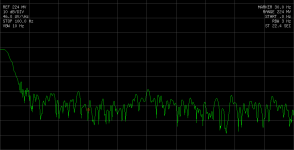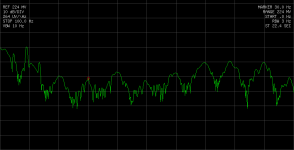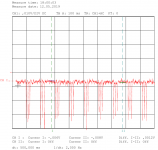Have you done it ?You can use your opamp to run high gain of >=100 to increase the noise output. Use an output filter to measure only the low frequency range e.g. < 1kHz or < 100Hz. Use battery powered little metallic case, put your opamp test circuit in there and use your scope to measure.
For DIY an absolute value is not needed as long as you have some sample opamp to compare. Buy some different "ultra low noise" opamps to compare ...
The above link from post #11 - popcorn noise measurement pdf will help you.
BR, Toni
Did you look at specs?When you need absolutely lowest noise then NE5532/34 is your component. Disadvantage is higher THD+N.
NE5532 Equivalent input noise voltage 5nV/ rt Hz
LM4562 is supposed to be 2.7nV/ rt Hz
The best are at 1.1nV/ rt Hz
I do not care about very low THD.
Last edited:
Are you kidding? I have done it measuring my own discrete opamp MyDOA v3.x and others years ago.😎Have you done it ?
You are completely ignoring current noise, the NE5532 is way better than the LM4562 for this. The balance between current and voltage noise depends on the source impedance, low voltage noise is good with 10 and 100 ohms levels of input impedance such as dynamic microphones and MC cartridges, low current noise is good at higher impedances (most opamp circuitry for instance, and MM cartridges). Divide the voltage noise by current noise to get a rough indication of the impedance an opamp is best at for noise.Did you look at specs?
NE5532 Equivalent input noise voltage 5nV/ rt Hz
LM4562 is supposed to be 2.7nV/ rt Hz
The best are at 1.1nV/ rt Hz
I do not care about very low THD.
Another myth due to marketing departments! They decide the voltage noise is suitable to headline a datasheet, leading to voltage noise density wars...
The LM4562 was moved from the obsoleted 6" wafer line to a new 8" wafer line, so it's very possible that both a) the 1/f noise issues have been minimized because of the new fab and b) the economics of the new line, finally replacing the leftover 6" parts, is more favorable than the obsoleted line, allowing a lower unit price.
And, what I just wrote (except for the very first statement about the new 8" wafer line) is complete speculation as well.
If you like the amplifier, which I do personally, then the new low prices should be welcome. It's sort of amazing to me how this thread has written off the LM4562 as a fire sale priced, charred carcass based on pretty much nothing but pessimistic speculation. There are a lot of other equally plausible but unfounded fantasies to choose from 🙂
Personally, I'm going to try to find some extremely new datecode parts and see how well they stack up re. popcorn. If my hopes come true, then the new 8" wafer parts, if that's what we're getting now, will behave a lot better than the older 6" wafer parts. I've used a number of 4562 recently, and indeed, some do have large 1/f noise, but not all. The problem is that nobody wants any of them to do this, and this might be possible with a different fab.
And, what I just wrote (except for the very first statement about the new 8" wafer line) is complete speculation as well.
If you like the amplifier, which I do personally, then the new low prices should be welcome. It's sort of amazing to me how this thread has written off the LM4562 as a fire sale priced, charred carcass based on pretty much nothing but pessimistic speculation. There are a lot of other equally plausible but unfounded fantasies to choose from 🙂
Personally, I'm going to try to find some extremely new datecode parts and see how well they stack up re. popcorn. If my hopes come true, then the new 8" wafer parts, if that's what we're getting now, will behave a lot better than the older 6" wafer parts. I've used a number of 4562 recently, and indeed, some do have large 1/f noise, but not all. The problem is that nobody wants any of them to do this, and this might be possible with a different fab.
Where op-amp input noise matters, I use Philips NE5533. http://images.100y.com.tw/pdf_file/NE5534N.pdf
Ultra low noise designs use low impedance sources. This is obvious.You are completely ignoring current noise, the NE5532 is way better than the LM4562 for this. The balance between current and voltage noise depends on the source impedance, low voltage noise is good with 10 and 100 ohms levels of input impedance such as dynamic microphones and MC cartridges, low current noise is good at higher impedances (most opamp circuitry for instance, and MM cartridges). Divide the voltage noise by current noise to get a rough indication of the impedance an opamp is best at for noise.
Another myth due to marketing departments! They decide the voltage noise is suitable to headline a datasheet, leading to voltage noise density wars...
There is no point for an ultra low equivallent input noise for noisy sources.
You are completely ignoring the contibution of the source noise.
En_total^2 = en^2 + ( Rs x in )^2 + 4kT x Rs
My lot of > 100 pcs LM4562 from digikey are looking good. Tested 10 randomly choosen opamps. No popcorn noise viewable. Prod/Shipping date: Oct 2018 in Malaysia
8AA1K7G3 - still with National Semi Logo.
Have compared them to some years old LM4562 - same results.
BR, Toni
8AA1K7G3 - still with National Semi Logo.
Have compared them to some years old LM4562 - same results.
BR, Toni
Obvious to you, but simply wrong. Condensor mics have extremely high impedance and require ultra low current noise in the buffer amp.Ultra low noise designs use low impedance sources. This is obvious.
There is nothing inherent about noise that implies low-impedance.
Impedance is the ratio of voltage to current.
Noise is a power thing. Every resistor value has the same noise power density,
so for a given power of signal the source resistance has nothing to do with signal to noise ratio.
This is clear if you play with signal transformers - a good signal transformer won't degrade SNR much, but can vastly change the impedance, and then back again. This used to be very useful before ultra low voltage noise amps were easy to make - simply boost the impedance and use a low current noise amp.
For any given impedance the amplifier should be chosen to perform well at that impedance, which for a 1 ohm source would be ultra-low noise voltage part, for a 1M source would be an ultra-low current noise part. This is why MM and MC premps have very different requirements since the 0.5H inductance of the typical MM cartridge will turn each pA of noise to 15nV at 5kHz (0.5H is about 15k ohms impedance at 5kHz).
This means a FET opamp or very low current noise bipolar are your choices for ultra low noise MM. In practice the RIAA slope helps a lot, and the fact surface noise is dominant.
You do not understand noise calculation.
Study this: En_total^2 = en^2 + ( Rs x in )^2 + 4kT x Rs
I am not interested anymore in your idle chat. Game over !
Study this: En_total^2 = en^2 + ( Rs x in )^2 + 4kT x Rs
I am not interested anymore in your idle chat. Game over !
Mark,
Thanks for your excellent explanation; it makes perfect sense to me!
For lowest noise performance, an amplifier should always be designed with the source impedance in mind. The condenser mic is a perfect example; in most products, a low noise FET amplifier is contained within the mic to lower the high capsule impedance (typically <200 ohm), allowing for long cable runs w/o signal degradation. Because the external microphone preamplifier sees the lower impedance, its design is often BJT based.
Thanks for your excellent explanation; it makes perfect sense to me!
For lowest noise performance, an amplifier should always be designed with the source impedance in mind. The condenser mic is a perfect example; in most products, a low noise FET amplifier is contained within the mic to lower the high capsule impedance (typically <200 ohm), allowing for long cable runs w/o signal degradation. Because the external microphone preamplifier sees the lower impedance, its design is often BJT based.
LM4562 and using the popcorn noise filter I can see the WLAN beacon of my home router.
The beacon interval is typical 100ms. Every exactly 100ms there are 3 short peaks viewable which can ruin the noise tests below 100Hz. It looks like the LM4562 RF immunity is not as good as compared to an old NE5532. But this may also be caused by the higher GBW of the LM4562.
So keep an eye on the pcb layout if you are using the LM4562 as ultra low noise opamp.
Switching off the WLAN router during measurements I even needed no extra shielding to get excellent and reproducible results.
BTW: no popcorn noise seen during testing the currently bought cheap batch of LM4562. Great opamp at a good price!
BR, Toni
The beacon interval is typical 100ms. Every exactly 100ms there are 3 short peaks viewable which can ruin the noise tests below 100Hz. It looks like the LM4562 RF immunity is not as good as compared to an old NE5532. But this may also be caused by the higher GBW of the LM4562.
So keep an eye on the pcb layout if you are using the LM4562 as ultra low noise opamp.
Switching off the WLAN router during measurements I even needed no extra shielding to get excellent and reproducible results.
BTW: no popcorn noise seen during testing the currently bought cheap batch of LM4562. Great opamp at a good price!
BR, Toni
It's really a challenge to control the oscillation. The 55MHz bandwidth is a drawback to the chip. This is not for amateurs ;-)
WLAN router is about 3 meters from testbed.
The dual opamp LM4562 is configured as shown in above popcorn measurement PDF from TI. Total gain is 10k.
The spectrum analyser range is set from 0Hz to 100Hz.
Dividing the uV/rthz output by 10000 gives nearly the nV/rthz.
The dual opamp LM4562 is configured as shown in above popcorn measurement PDF from TI. Total gain is 10k.
The spectrum analyser range is set from 0Hz to 100Hz.
Dividing the uV/rthz output by 10000 gives nearly the nV/rthz.
- Picture 1 testbed without opamp inserted. WLAN off
- Picture 2 shows about 4.6nV/rtHz at 30Hz. WLAN off
- Picture 3 shows measurement with WLAN active
- Picture 4 shows the WLAN beacon peaks at output after LPF filter of measurement setup.
Attachments
Last edited:
- Status
- Not open for further replies.
- Home
- Design & Build
- Parts
- LM4562 for $1.60



